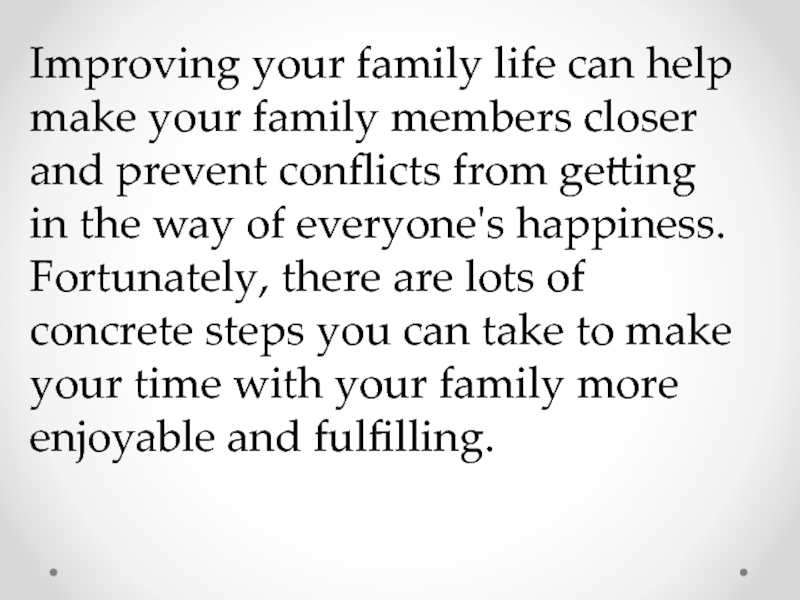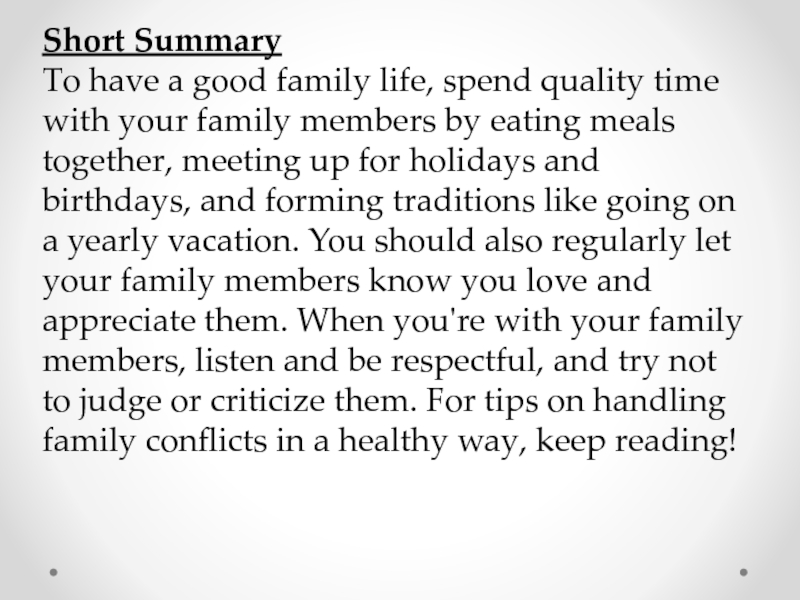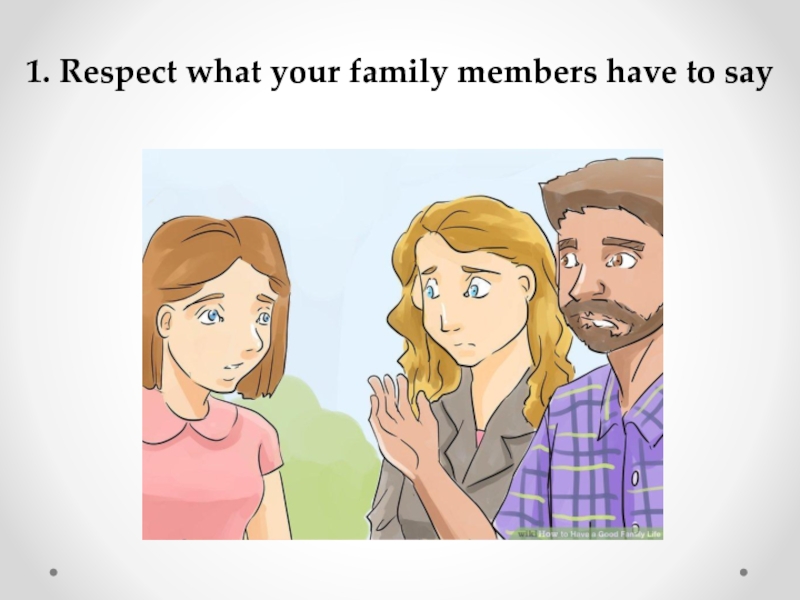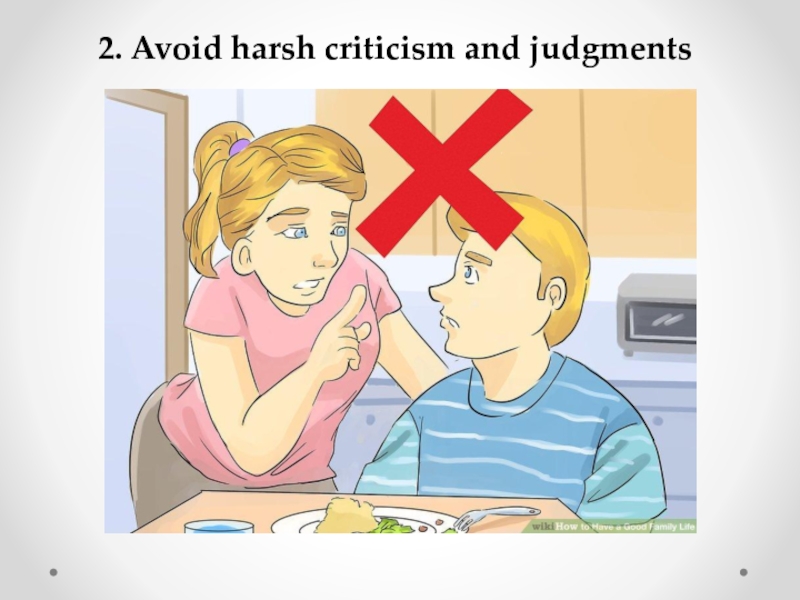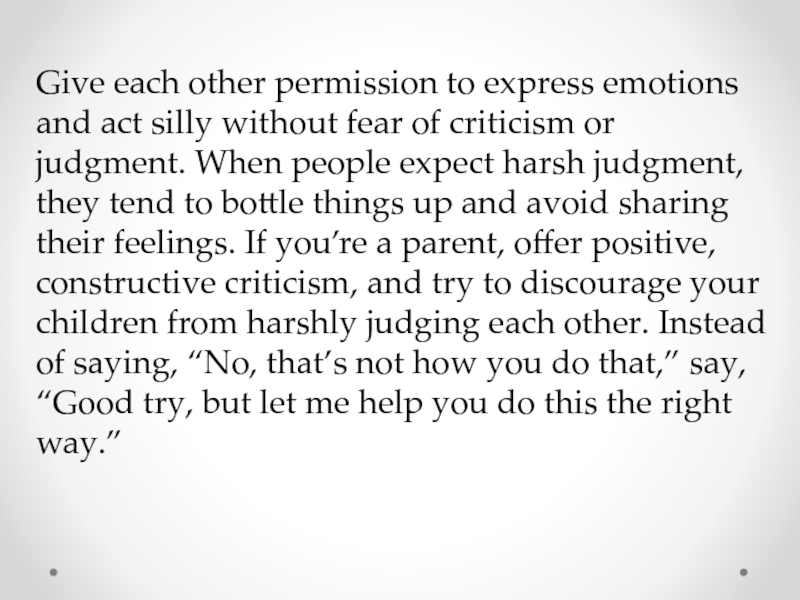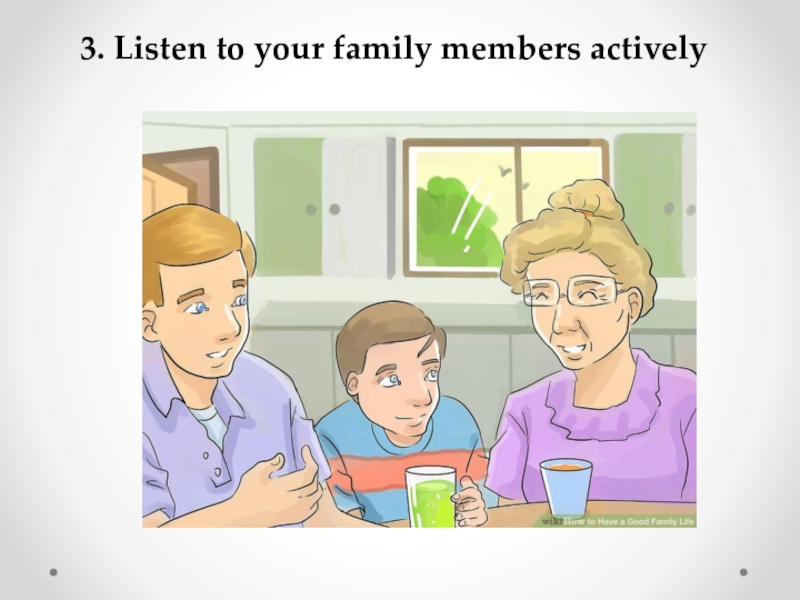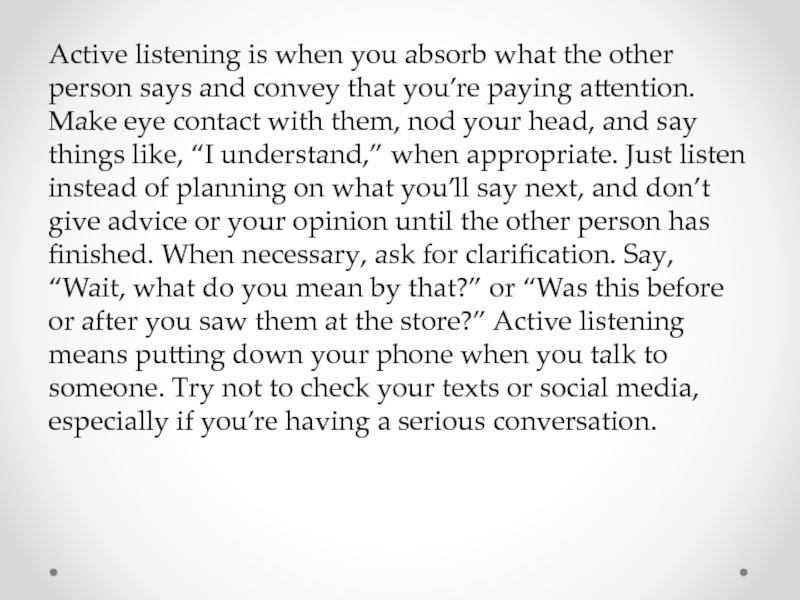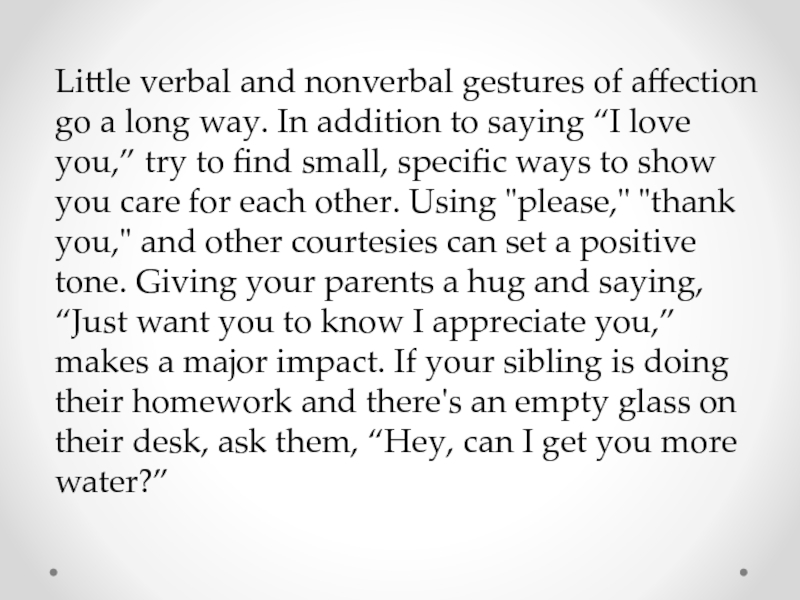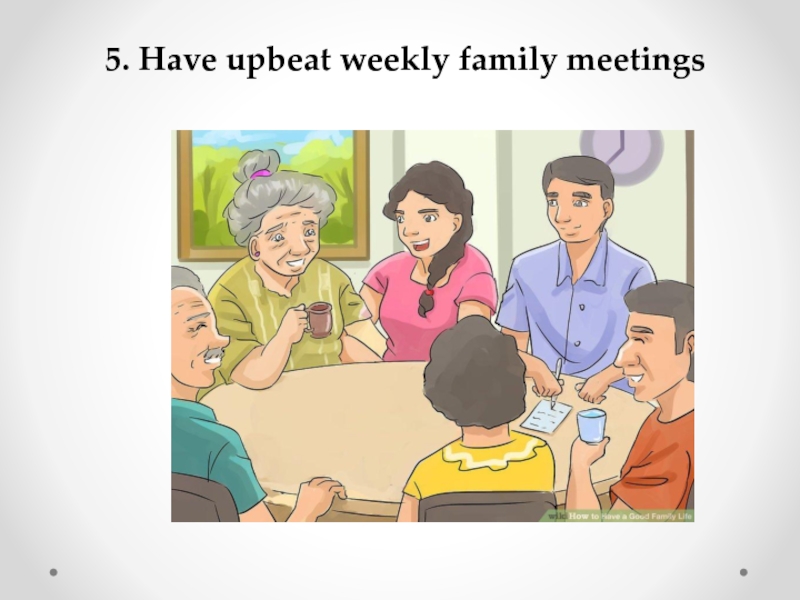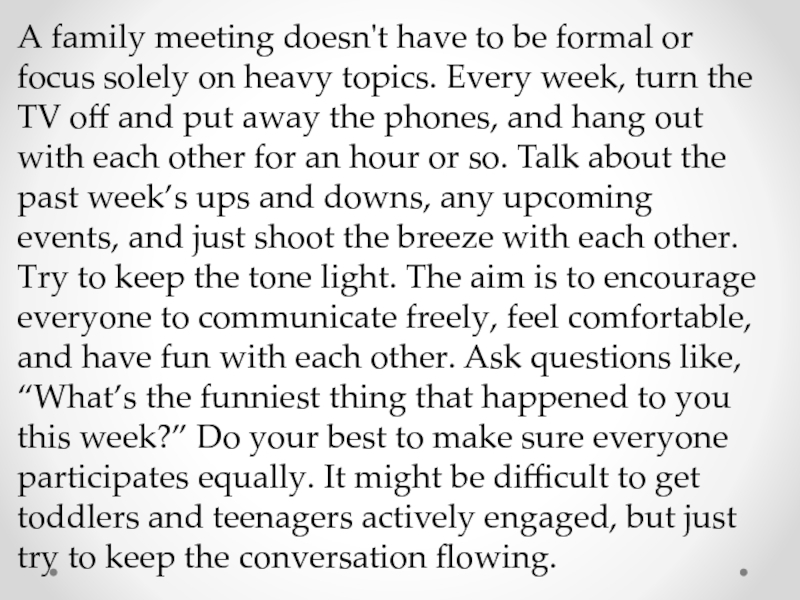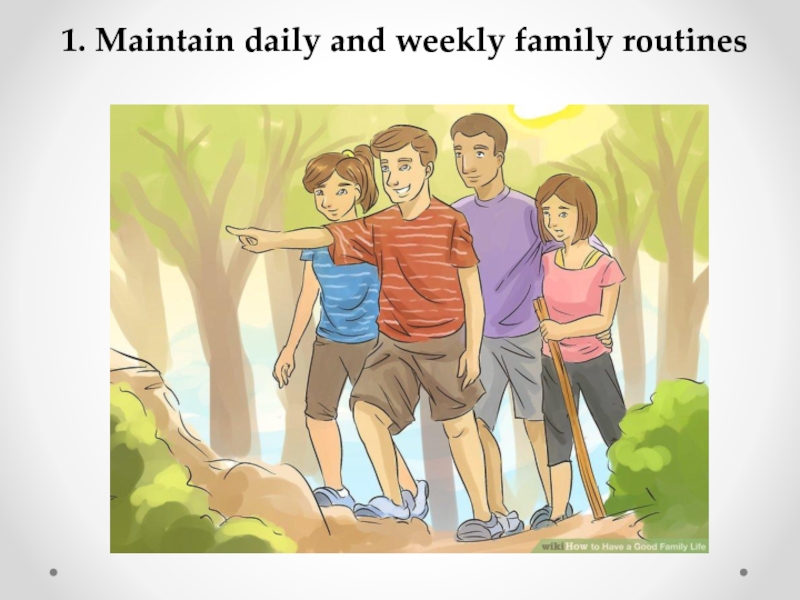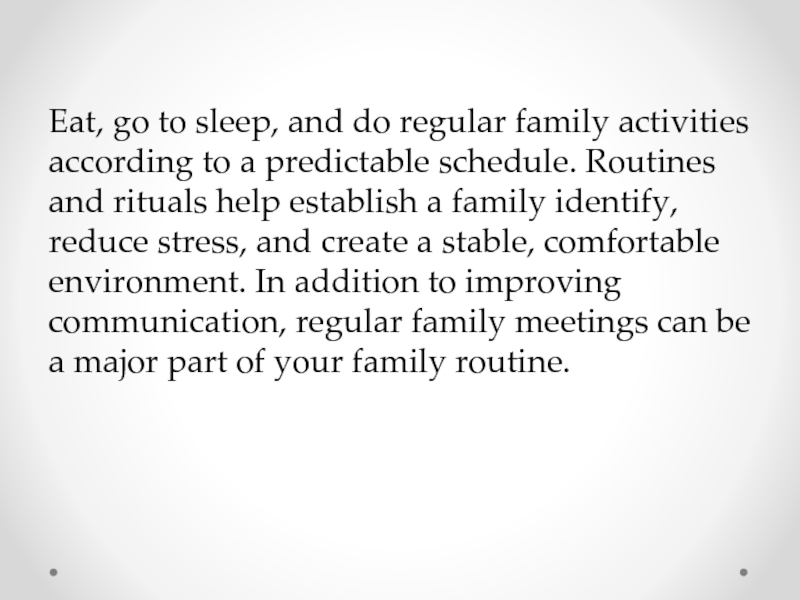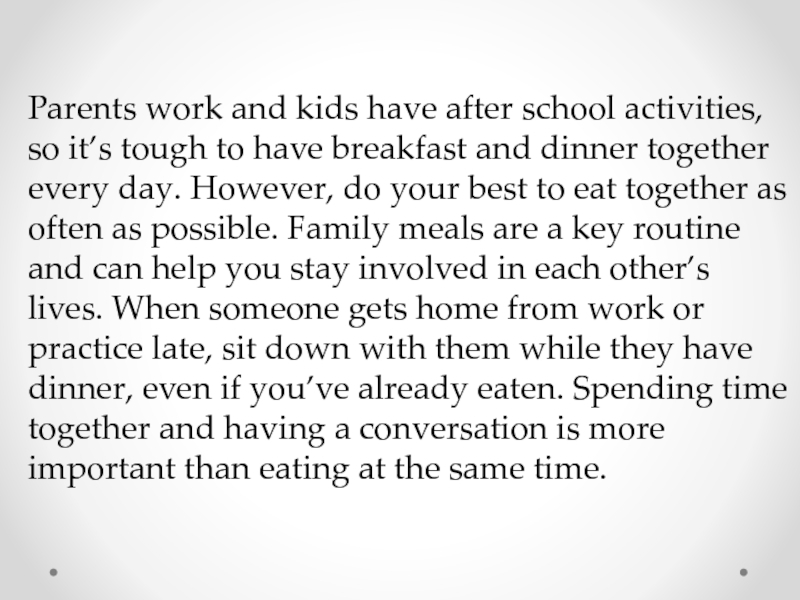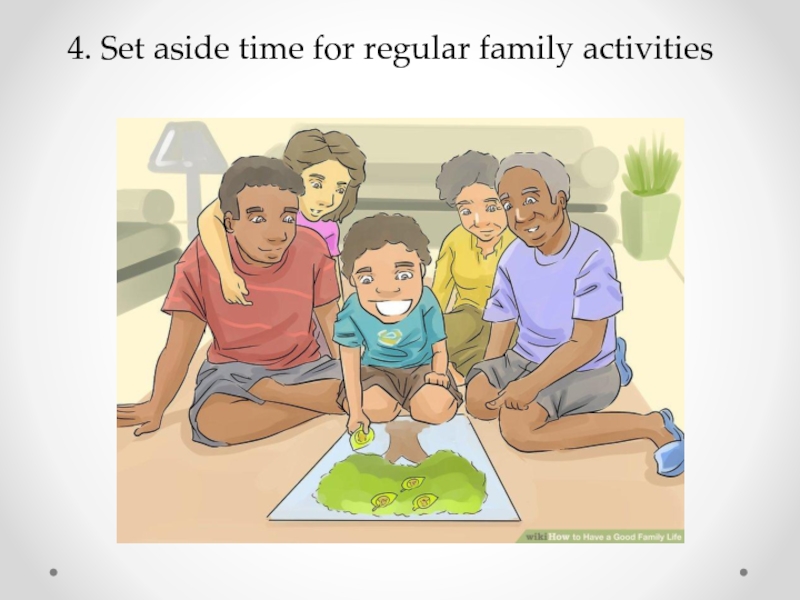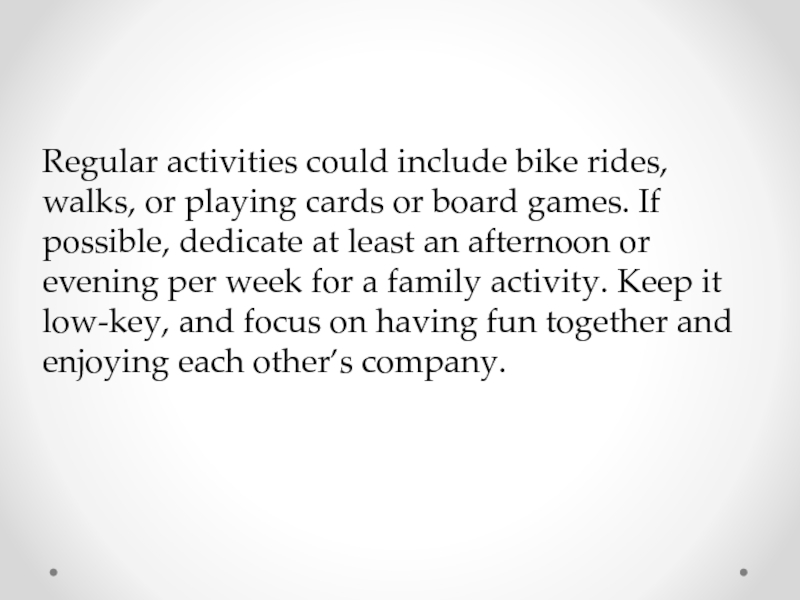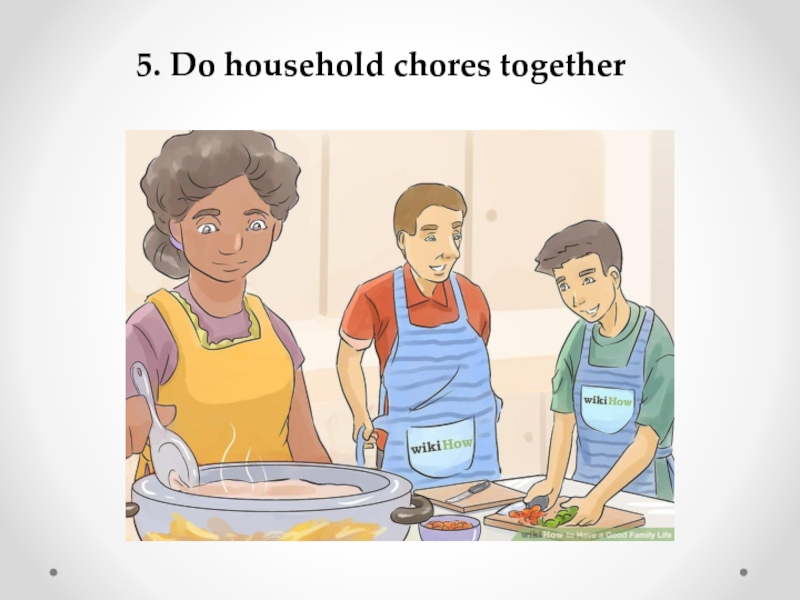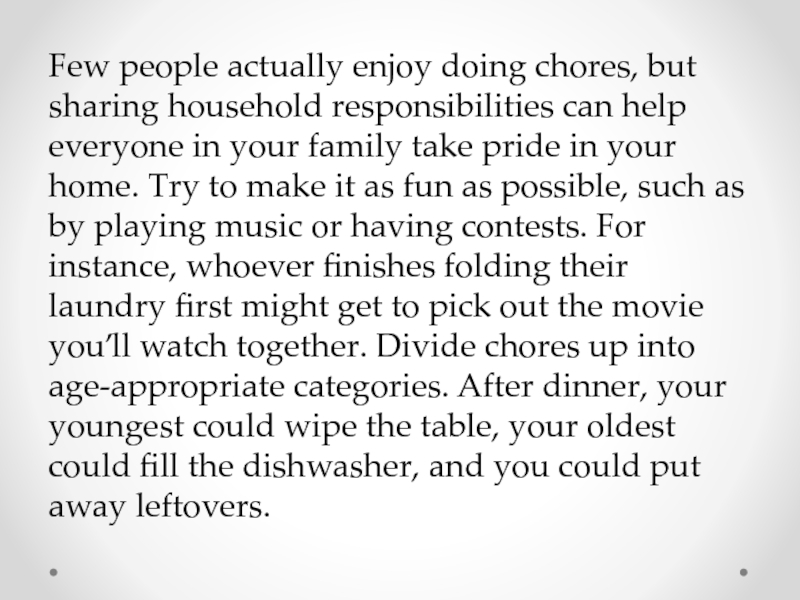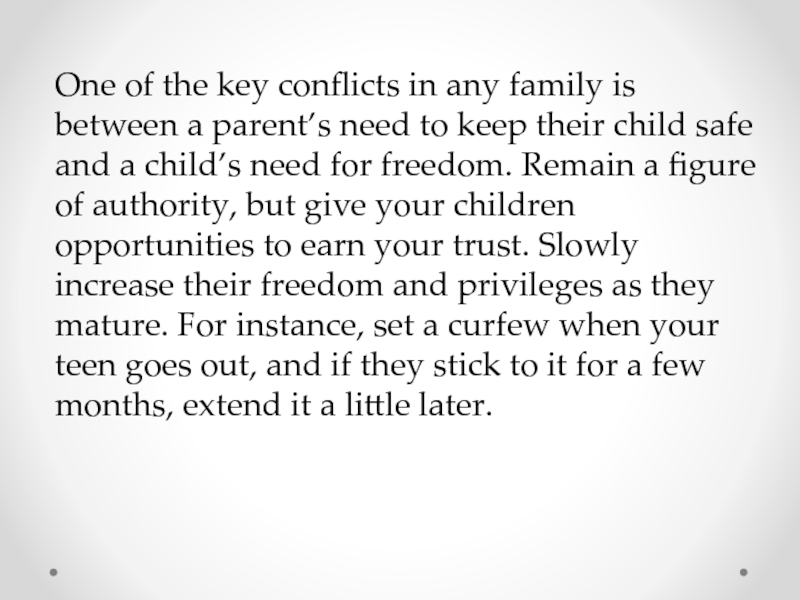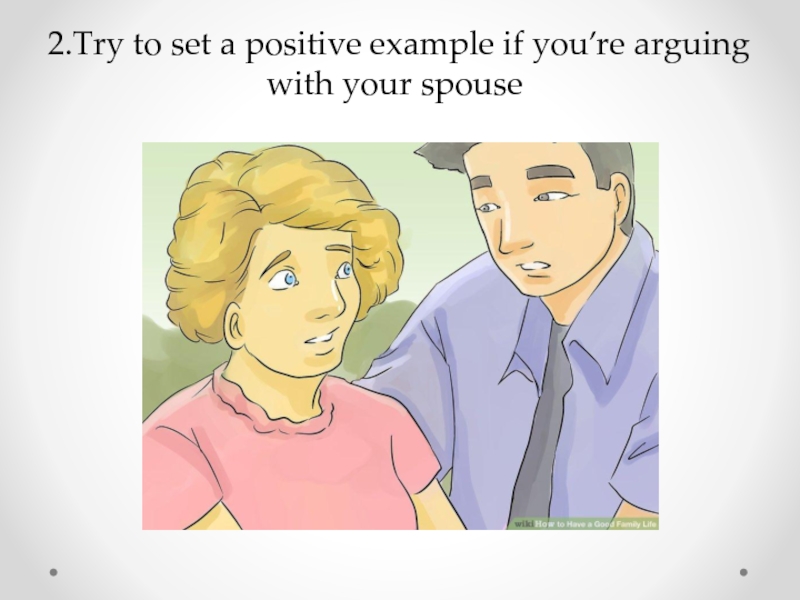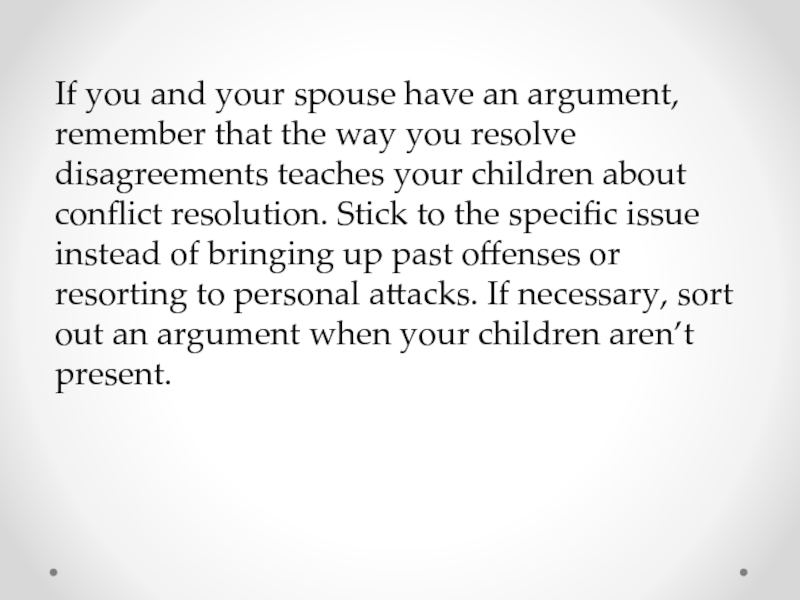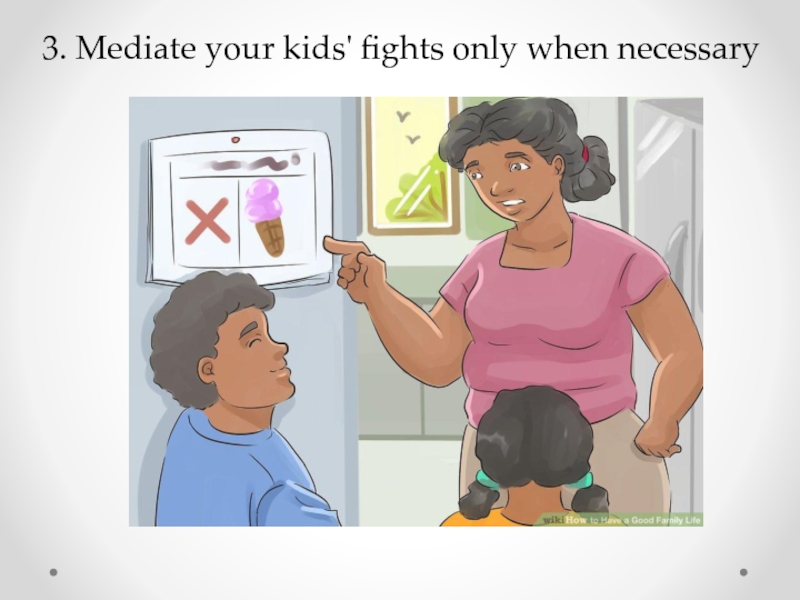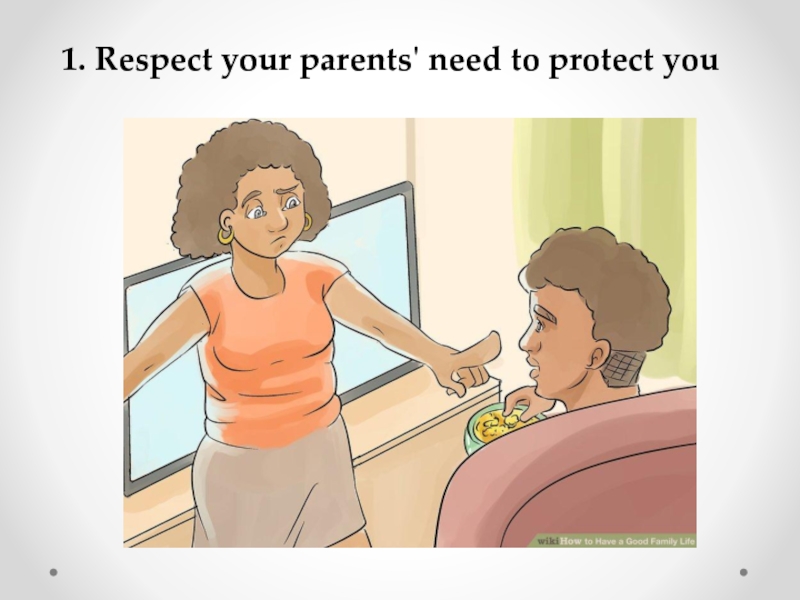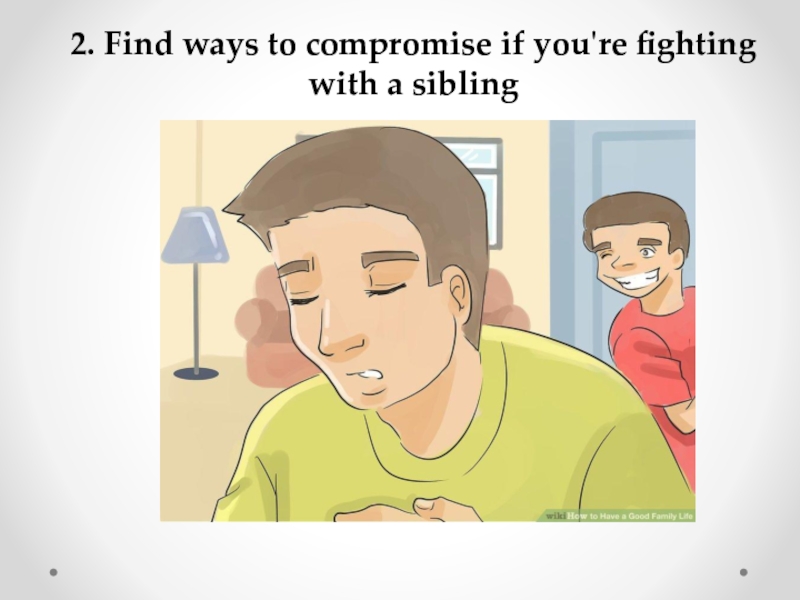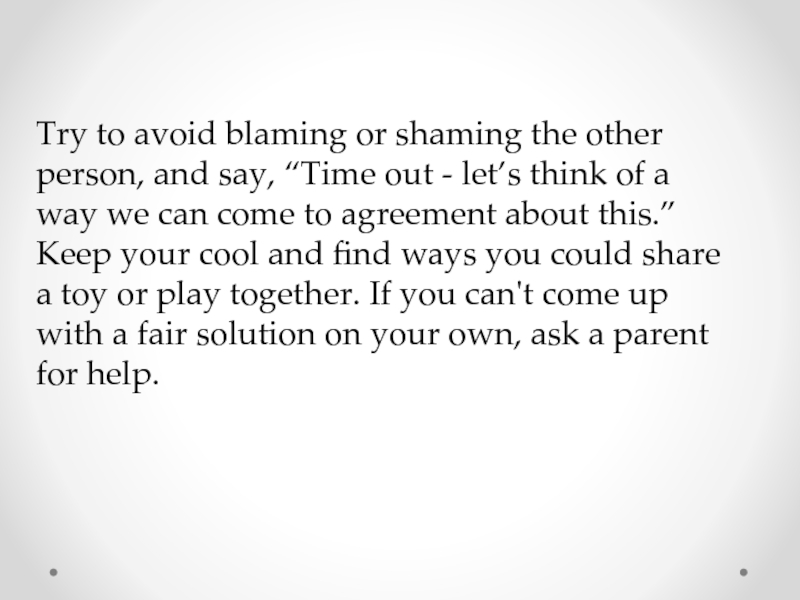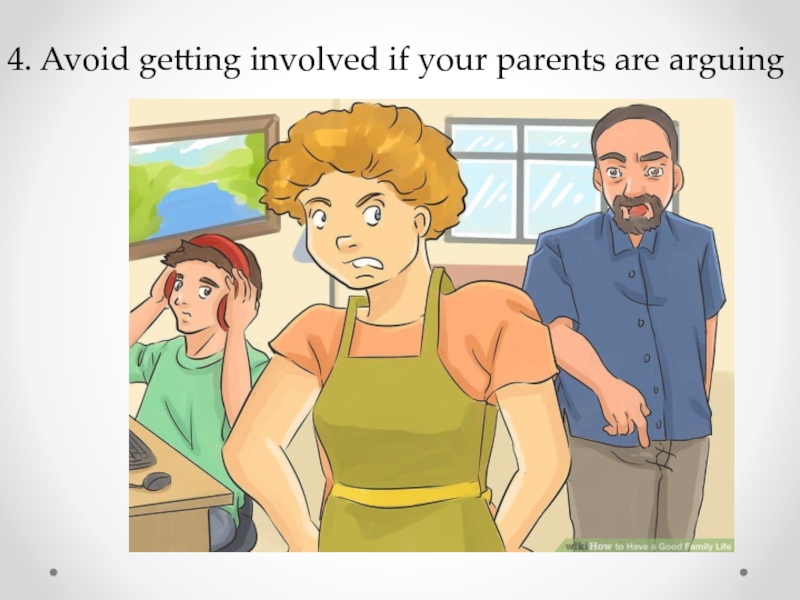- Главная
- Разное
- Дизайн
- Бизнес и предпринимательство
- Аналитика
- Образование
- Развлечения
- Красота и здоровье
- Финансы
- Государство
- Путешествия
- Спорт
- Недвижимость
- Армия
- Графика
- Культурология
- Еда и кулинария
- Лингвистика
- Английский язык
- Астрономия
- Алгебра
- Биология
- География
- Детские презентации
- Информатика
- История
- Литература
- Маркетинг
- Математика
- Медицина
- Менеджмент
- Музыка
- МХК
- Немецкий язык
- ОБЖ
- Обществознание
- Окружающий мир
- Педагогика
- Русский язык
- Технология
- Физика
- Философия
- Химия
- Шаблоны, картинки для презентаций
- Экология
- Экономика
- Юриспруденция
How to Have a Good Family Life презентация
Содержание
- 1. How to Have a Good Family Life
- 2. Improving your family life can help make
- 3. Short Summary To have a good family
- 4. Method 1 Improving Communication
- 5. 1. Respect what your family members have to say
- 6. When someone expresses an opinion, don't dismiss
- 7. 2. Avoid harsh criticism and judgments
- 8. Give each other permission to express emotions
- 9. 3. Listen to your family members actively
- 10. Active listening is when you absorb what
- 11. 4. Express love and appreciation frequently
- 12. Little verbal and nonverbal gestures of affection
- 13. 5. Have upbeat weekly family meetings
- 14. A family meeting doesn't have to be
- 15. Method 2. Spending Quality Time Together
- 16. 1. Maintain daily and weekly family routines
- 17. Eat, go to sleep, and do regular
- 18. 2. Make celebrating birthdays and holidays together a family tradition
- 19. You don’t have to do the same
- 20. 3. Have meals together as often as possible
- 21. Parents work and kids have after school
- 22. 4. Set aside time for regular family activities
- 23. Regular activities could include bike rides, walks,
- 24. 5. Do household chores together
- 25. Few people actually enjoy doing chores, but
- 26. Method 3. Handling Conflicts as a Parent
- 27. 1.Balance your role as a parent with your child’s need for freedom
- 28. One of the key conflicts in any
- 29. 2.Try to set a positive example if you’re arguing with your spouse
- 30. If you and your spouse have an
- 31. 3. Mediate your kids' fights only when necessary
- 32. If possible, let your kids sort out
- 33. 4. Communicate clearly and directly when resolving disagreements.
- 34. Avoid being passive-aggressive, vague, or sarcastic, especially
- 35. Method 4. Handling Conflicts as a Child
- 36. 1. Respect your parents' need to protect you
- 37. While children need increasing degrees of freedom
- 38. 2. Find ways to compromise if you're fighting with a sibling
- 39. Try to avoid blaming or shaming the
- 40. 3. Try to see things from your family member’s point of view
- 41. Before jumping to conclusions, take a deep
- 42. 4. Avoid getting involved if your parents are arguing
Слайд 2Improving your family life can help make your family members closer
and prevent conflicts from getting in the way of everyone's happiness. Fortunately, there are lots of concrete steps you can take to make your time with your family more enjoyable and fulfilling.
Слайд 3Short Summary To have a good family life, spend quality time with
your family members by eating meals together, meeting up for holidays and birthdays, and forming traditions like going on a yearly vacation. You should also regularly let your family members know you love and appreciate them. When you're with your family members, listen and be respectful, and try not to judge or criticize them. For tips on handling family conflicts in a healthy way, keep reading!
Слайд 6When someone expresses an opinion, don't dismiss it or interrupt them
before they can finish speaking. Maintaining open, respectful communication channels will help your family develop trust and strengthen your bond. For instance, avoid making fun of your siblings whenever they express an opinion. If your siblings pick on you, try telling them, “I know that all brothers and sisters mess with each other, but it hurts my feelings when you make fun of everything I say.”
Слайд 8Give each other permission to express emotions and act silly without
fear of criticism or judgment. When people expect harsh judgment, they tend to bottle things up and avoid sharing their feelings. If you’re a parent, offer positive, constructive criticism, and try to discourage your children from harshly judging each other. Instead of saying, “No, that’s not how you do that,” say, “Good try, but let me help you do this the right way.”
Слайд 10Active listening is when you absorb what the other person says
and convey that you’re paying attention. Make eye contact with them, nod your head, and say things like, “I understand,” when appropriate. Just listen instead of planning on what you’ll say next, and don’t give advice or your opinion until the other person has finished. When necessary, ask for clarification. Say, “Wait, what do you mean by that?” or “Was this before or after you saw them at the store?” Active listening means putting down your phone when you talk to someone. Try not to check your texts or social media, especially if you’re having a serious conversation.
Слайд 12Little verbal and nonverbal gestures of affection go a long way.
In addition to saying “I love you,” try to find small, specific ways to show you care for each other. Using "please," "thank you," and other courtesies can set a positive tone. Giving your parents a hug and saying, “Just want you to know I appreciate you,” makes a major impact. If your sibling is doing their homework and there's an empty glass on their desk, ask them, “Hey, can I get you more water?”
Слайд 14A family meeting doesn't have to be formal or focus solely
on heavy topics. Every week, turn the TV off and put away the phones, and hang out with each other for an hour or so. Talk about the past week’s ups and downs, any upcoming events, and just shoot the breeze with each other. Try to keep the tone light. The aim is to encourage everyone to communicate freely, feel comfortable, and have fun with each other. Ask questions like, “What’s the funniest thing that happened to you this week?” Do your best to make sure everyone participates equally. It might be difficult to get toddlers and teenagers actively engaged, but just try to keep the conversation flowing.
Слайд 17Eat, go to sleep, and do regular family activities according to
a predictable schedule. Routines and rituals help establish a family identify, reduce stress, and create a stable, comfortable environment. In addition to improving communication, regular family meetings can be a major part of your family routine.
Слайд 19You don’t have to do the same thing every birthday or
holiday. For instance, you could go to a family member’s favorite restaurant or do their favorite activity on their birthday. You’d be sticking to a tradition, but the activities would be varied.
Слайд 21Parents work and kids have after school activities, so it’s tough
to have breakfast and dinner together every day. However, do your best to eat together as often as possible. Family meals are a key routine and can help you stay involved in each other’s lives. When someone gets home from work or practice late, sit down with them while they have dinner, even if you’ve already eaten. Spending time together and having a conversation is more important than eating at the same time.
Слайд 23Regular activities could include bike rides, walks, or playing cards or
board games. If possible, dedicate at least an afternoon or evening per week for a family activity. Keep it low-key, and focus on having fun together and enjoying each other’s company.
Слайд 25Few people actually enjoy doing chores, but sharing household responsibilities can
help everyone in your family take pride in your home. Try to make it as fun as possible, such as by playing music or having contests. For instance, whoever finishes folding their laundry first might get to pick out the movie you’ll watch together. Divide chores up into age-appropriate categories. After dinner, your youngest could wipe the table, your oldest could fill the dishwasher, and you could put away leftovers.
Слайд 28One of the key conflicts in any family is between a
parent’s need to keep their child safe and a child’s need for freedom. Remain a figure of authority, but give your children opportunities to earn your trust. Slowly increase their freedom and privileges as they mature. For instance, set a curfew when your teen goes out, and if they stick to it for a few months, extend it a little later.
Слайд 30If you and your spouse have an argument, remember that the
way you resolve disagreements teaches your children about conflict resolution. Stick to the specific issue instead of bringing up past offenses or resorting to personal attacks. If necessary, sort out an argument when your children aren’t present.
Слайд 32If possible, let your kids sort out their arguments on their
own. Set ground rules and intervene only when the rules are broken or your kids can't cool down by themselves. Ground rules include no hitting, cursing, or name-calling. Tell them that they need to let the other person speak and discuss their issue calmly. If a fight escalates, separate your kids until they cool down, then help them find a compromise. Tell them that your role isn't to assign blame (unless one cursed at or hit the other), but to help figure out the best solution.
Слайд 34Avoid being passive-aggressive, vague, or sarcastic, especially when handling a conflict.
Say what’s on your mind, and encourage your family members to do the same. For example, if your child didn’t take out the trash, don’t give them the cold shoulder or vaguely convey that you’re upset. Instead of saying, “It’s disappointing when people forget to do their chores,” be direct. Say, “Sam, I’m disappointed that you didn’t take out the trash this week. I’m taking away your allowance if it happens again.”
Слайд 37While children need increasing degrees of freedom as they get older,
remember that your parents are in charge. Their job is to keep you safe and give you the tools you'll need to take care of yourself when you're an adult. If your parent doesn't allow you to go out without an adult or makes you go to bed early, remember that they have your best interests in mind. When your parent is open to negotiating something, like a curfew, talk to them in a mature manner. Make your case calmly and clearly, and don't whine or yell to get your way if they say no.
Слайд 39Try to avoid blaming or shaming the other person, and say,
“Time out - let’s think of a way we can come to agreement about this.” Keep your cool and find ways you could share a toy or play together. If you can't come up with a fair solution on your own, ask a parent for help.
Слайд 41Before jumping to conclusions, take a deep breath and try to
stay calm. If someone ate your favorite snack or stole your clothes, try to see things from their perspective before getting angry. For instance, if your sibling stole something that belongs to you, such as a jacket, makeup, or a watch, say to yourself, “I really don’t think they did this to spite me. They probably just want to wear this to school and look cool.” Tell them, “I know you really like my leather jacket. I understand that it makes you feel cool. But it belongs to me and you can’t just take something without asking.”

